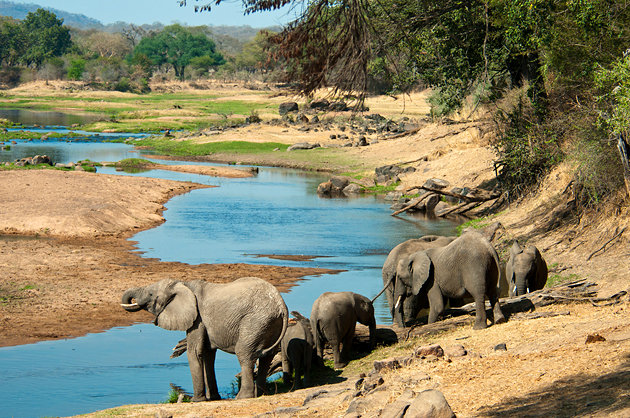Southern Circuit

Selous
The Selous Game Reserve, with an area of about 55,000 sq. km, is the largest well-watered wildlife sanctuary in Africa, and one of the largest protected areas in the world. Its size is simply stunning, bigger than Switzerland, uninhabited and little touched by human interference. It is perhaps the most pristine wilderness still remaining in Africa, with a wide variety of wildlife habitats, including open grasslands, Acacia and miombo woodlands, swamps and riverine forests in the many tributaries of the mighty Rufiji River which flows through the reserve. Due to its unique ecological importance, it was designated a World Heritage Site by the United Nations in 1982.
Its wildlife is spectacular, with some of its mammal and reptile populations are the largest in Africa, namely buffaloes, elephants, hippos, wild dogs and crocodiles. Other wildlife include the wildebeest, impala, waterbuck, zebra, eland, the greater kudu, sable antelopes, giraffe, baboon, the vervet and blue monkeys, and the black and white colobus monkey which can be seen in certain riverine forests moving from tree to tree in family groups. There is a large population of predators including lions, leopards, cheetah and the spotted hyena, and about 440 species of birds in the Selous, of both resident and migratory birds.
Mikumi
Forming the northern border of Africa's biggest game reserve, the Selous, Mikumi National Park is only three to four hours drive from Dar es Salaam, lying astride the main highway to Zambia, and en route to the National Parks of Ruaha and Udzungwa Mountains. The main feature of the park is the Mikumi flood plain, along with the mountain ranges that border the park on two sides. Open grasslands dominate in the flood plain, eventually merging with the miombo woodland covering the lower hills. The park is rich in wildlife. And animals like buffaloes, hippos, baboons, sable antelopes, lions, wild dogs, wildebeests, zebras, impalas, giraffe, warthogs, and elephants which can easily be viewed all the year round. Reptiles including crocodiles, monitor lizards and pythons are also resident in the park. Over 300 species of bird have been recorded some of which are Eurasian migrants.
Southern Circuit
If your looking for plentiful and rare wildlife in a remote area of Africa then Southern Tanzania is the place you have to visit. The national parks have fewer visitors and give the feeling of being all alone. Activities include game drives in open vehicles, boat safaris, and walking safaris. These safaris include flights between the parks.
Ruaha
Ruaha National Park derives its name from the Ruaha River, which flows along its southeastern border. The river provides permanent water in the park and, during the dry season, animal concentration along its banks is spectacular.
Ruaha National Park is about two to three hours drive from Iringa, a famous town on the Dar es Salaam to Zambia highway, and covers an area of 12, 950sq km, making it the second largest National Park in Tanzania, after Serengeti. This unspoilt wilderness is rich in flora (about 1650 plant species) and fauna, and contains a wide variety of animals that includes Greater and Lesser Kudu, roan and sable antelopes, which are rarely seen in most other game parks especially in Northern Tanzania. Ruaha National Park is famous for its herds of elephant and buffaloes.
The Ruaha River, which plays an important role in the ecosystem of the park, provides sanctuary to a large number of hippos and crocodiles. During the dry season the river attracts great quantities of game including lions, leopard, hunting or wild dog, impala, waterbuck, warthog, giraffe, and elands. In the plains ostriches, cheetahs and Grants Gazelles can be seen. The park is rich in bird life throughout the year, with over 370 bird species recorded. The best time for game viewing is during the dry season, from May to December. During the wet months from January to April some tracks become impassable.
Saadani
Located only 130 km north of Dar es salaam and directly to the west of Zanzibar, Saadani is the only coastal wildlife sanctuary in East Africa, which not only means relaxing on Indian Ocean beaches after each safari, but provides the opportunity to observe Africa's big game and birdlife interacting with the sea. The Reserve, about 1000 sq. km in size, is being considered for upgrade to the National Park status.
Saadani has a diverse population of mammals and birds. Elephant, leopard, lion, buffalo, giraffe, wildebeest, zebra, colobus monkey, hippo, crocodile and the rare Roosevelt sable can be seen here. Saadani offers a choice of a driving safari, nature walk, and boat safari.

Best time to Southern Circuit
Best time to go:
June to October
High Season:
June to October (Ruaha rarely experiences crowding at any time)
Low Season:
April and May (Many lodges close)
Best Weather:
June to October (Rains are extremely uncommon)
Worst Weather:
November to March (Wet season)

